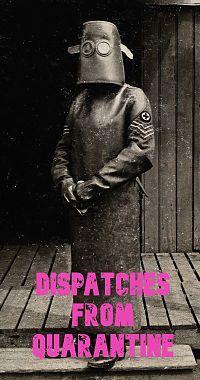 So here we are in a situation which by definition makes putting on theatre impossible in the foreseeable future.
So here we are in a situation which by definition makes putting on theatre impossible in the foreseeable future.
But some of us want to keep making plays and engaging audiences. If for the time being we can’t engage audiences in person, technology offers us an opportunity to do it virtually. Many have done this on a rudimentary level via Zoom readings online. Some of these efforts have been brilliant (e.g., Richard Nelson’s new play about the Apple family, What Do We Need to Talk About?), and some have been earnest but clumsy (supply your own e.g.’s). But, taking inspiration from a model that existed during the so-called Golden Age of Television, I would like to propose another model.
In the 1950s, a number of TV series offered new plays written expressly to be produced within the confines of the television studio. There were no live audiences. These tended to be intense works played out in limited spaces. On outlets such as Playhouse 90, Studio One, The United States Steel Hour, and Armstrong Circle Theatre, actors, writers, and directors recruited largely from the New York theatre community collaborated on live broadcasts. The playwrights included Horton Foote, Paddy Chayefsky, Rod Serling, Gore Vidal, Reginald Rose, JP Miller, William Gibson, and Tad Mosel; the directors included Arthur Penn, Sidney Lumet, John Frankenheimer, Delbert Mann, and Fred Coe. Among the works that saw first exposure in this medium, and later were developed into notable plays and films, were The Trip to Bountiful, Twelve Angry Men, The Miracle Worker, Requiem for a Heavyweight, The Days of Wine and Roses and Marty.
Though the audiences for these TV dramas weren’t physically present, viewers at home were plentiful and responsive. Tad Mosel remembered sitting in a studio during a broadcast of one of his plays and realizing that at that moment his work was reaching an audience of 50 million. Rod Steiger recalled that the day after he starred in Marty on television, people hailed him on the street. These plays were also taken seriously by television critics, who frequently emulated theatre critics in printing overnight reviews. Sometimes a play was such a hit that it was repeated—and, since this was before videotape had been perfected and was in common use, repeating a play meant reassembling the sets and performing it again live. Some of the most popular plays of this bunch were published.
What does this have to do with today?
There’s been a lot of talk about finding ways to film and broadcast fully staged productions, à la National Theatre Live. What I’d like to see is both more modest and more ambitious: a TV series that brings together leading nonprofit theatres to stage new plays appropriate to production in studios without audiences. This may discourage broad comedies and musicals, which thrive on laughter and applause, but it would still allow for a wide range of potential material. Protocols are now being established in Hollywood and New York for studio work designed to protect the safety of cast and crew, and these would make production on this scale possible.

Obviously, as soon as these protocols are in place, we will also see a return to usual production of TV and film. But the series I envision would emphasize its roots in theatre. Just looking at New York’s nonprofits, Lincoln Center, the Public, Playwrights Horizons, New York Theater Workshop, the Signature, the New Federal Theater, and so on could be the primary producers. And theatre practices would prevail, including contracts observing the playwright’s traditional rights. After their broadcast, these teleplays would be available on-demand from whatever the host platform is. (I suggest NY-based theatres here in part because the TV networks have headquarters in NYC, but there would be nothing to stop more localized efforts.)
I would urge that they be produced live to give them that sense of edge. There’s even an audience primed for this kind of appointment television: We have seen a number of networks offer successful live musical productions, from Grease to Jesus Christ Superstar. The sense of danger boosts the energy—though, for safety’s sake, these projects do videotape the dress rehearsals in case, as happened with the broadcast of Rent, something goes wrong in the live broadcast.
Why turn to theatres to do this rather than through conventional TV production offices? For one thing, to keep the names of the companies and their affiliated artists fresh in audiences’ minds so that they look forward all the more to their return to live production. The revenue stream and employment wouldn’t hurt either. And since these shows would be aired nationally, they could expand national awareness of the theatre and even boost post-pandemic theatre attendance. I think new works by our major dramatists presented live would stimulate the national conversation, and I bet that artists weary of Zoom readings would be happy to join.
Theatres haven’t got the resources to put this series together on their own, of course. These days, most are focusing on trying to survive. This idea requires those with deep pockets to be motivated to put their weight behind it. In a recent article in The Guardian, British director Sam Mendes suggested that, since Netflix has gained a windfall of subscribers because of the pandemic, it would make moral sense for it to come to the aid of theatres. Given that much of the talent behind Netflix’s productions got their start onstage, supporting theatre companies would be an appropriate way to give a little back.
If a few high-profile folks with backgrounds in the theatre and access to funding were to use their influence to get this going, a modern Playhouse 90 could be a dynamic and productive way to keep the theatre community alive in the meantime. And it would improve on the original model in offering opportunities for a more diverse group of artists than were welcome in those studios in the ’50s.
As for the shared satisfaction of curtain calls? Okay, sending thumbs-up signs from our couches may not cut it. For that, we’re going to have to wait until we can again face real people in public spaces.
Jeffrey Sweet is a playwright and the author of Something Wonderful Right Away (about Second City) and The O’Neill (about the Eugene O’Neill Memorial Theater Center). He serves on the Council of the Dramatists Guild.

